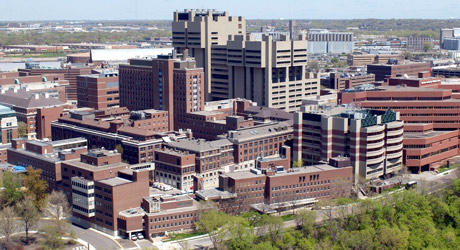School of Dentistry secures $1.7 million grant to reduce oral health disparities in rural communities

A grant through the Health Resources and Services Administration (HRSA) of the U.S. Department of Health will fund a five-year program called the Minnesota Collaborative Rural Oral Health Project (MN-CROHP), led by the University of Minnesota School of Dentistry.
MN-CROHP aims to expand access to care in underserved rural Minnesota communities by integrating interprofessional education and using more mid-level providers. This new care model will blend medical, dental and dental therapy students in rural clinics, giving patients a full spectrum of oral health care. The project will target 3 rural regions: Northeast MN (Aitkin, Cass, Crow Wing, and Itasca counties); West Central MN (Big Stone, Chippewa, Kandiyohi, Lac qui Parle, Stevens, Swift and Traverse counties); and Southeast MN (Fillmore, Freeborn, and Winona counties).
“There is a huge need for dentists in greater Minnesota,” said Naty Lopez, Ph.D., principal investigator and assistant dean for admissions and diversity at the School of Dentistry. “Many are retiring, and there aren’t enough students returning to rural areas to take their place.”
According to the Minnesota Department of Health, 75 percent of Minnesota rural dentists were 45 years or older as of 2008. Many of them will retire in the next five to ten years.
A primary objective of the project is to match dental and dental therapy students with dentist mentors in smaller communities, to expose them to career options in rural areas.
“By partnering with local dentists, our students will become more immersed in the community, and get an idea of what it means to work in a rural practice,” Lopez said. “We hope that this will help sustain an interest in rural dentistry, and that more students will consider practicing in a rural or underserved region after graduation.”
The project will also:
- Assess the oral health needs of k-12 students through free oral screenings by the Minnesota Department of Health (MDH) and dentistry students at health education sessions
- Collaborate with the Medical School's Rural Physician Associate Program (RPAP) residents to integrate oral health into health care systems
- Expand capabilities of existing rural practices by adding mid-level providers to the care team
Beyond MN-CROHP, School of Dentistry students treat patients in campus clinics and 11 communities around the state, including two clinics for children and adults with special needs, a geriatric clinic, and three hospital-based clinics.
“Access to dental care is a major concern in Minnesota, and we’ve launched a number of initiatives designed to enhance access,” says Leon Assael, D.M.D., dean of the School of Dentistry. “We’re focusing efforts on addressing the health needs of our state, and MN-CROHP is an exciting new opportunity to achieve that goal.”
Lopez will finalize the MN-CROHP plan in the coming months, alongside program collaborators and University of Minnesota co-investigators Karl Self, D.D.S., director of the division of dental therapy and Karin Quick, Ph.D., D.D.S., director of the division dental public health. The project’s partner organizations include MDH, RPAP, the Minnesota Dental Association, and various K-12 schools in rural communities.
Grant administrators expect to implement the plan in summer of 2016.